What causes neck and shoulder pain?
When can you try yoga for neck and shoulder pain?
Would you like to watch the poses in a video? Watch the video below.
10 Best Yoga Poses for Tech Neck and Shoulder Pain
1. Child’s pose (Balasana)
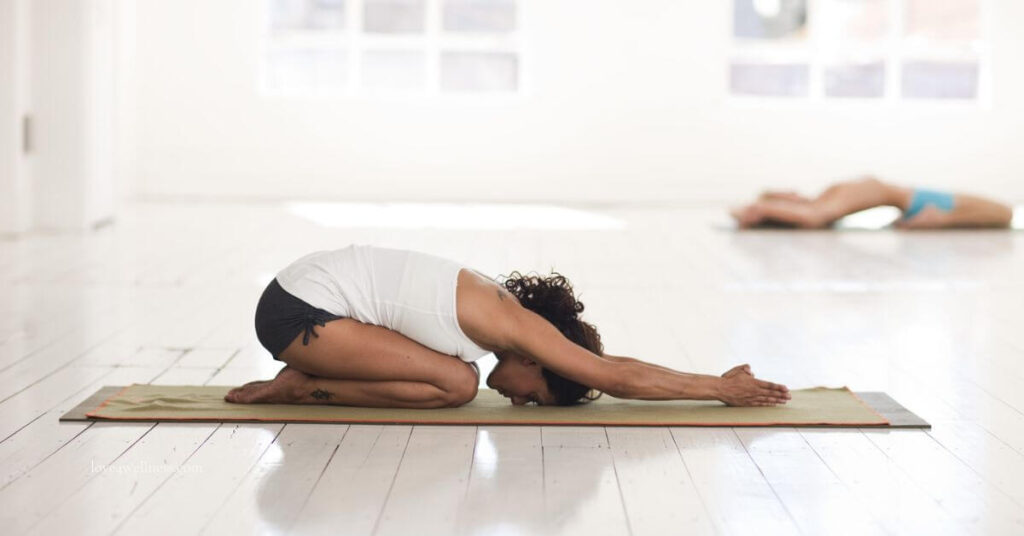
This gentle resting pose is excellent for releasing tension in the back, shoulders, and neck.
How to do it:
- Start on your hands and knees in a tabletop position.
- Bring your big toes together and spread your knees as wide as your hips or a little wider.
- On an exhale, sink your hips back towards your heels.
- Walk your hands forward, resting your torso between your thighs.
- Allow your forehead to rest on the mat, or on a block or blanket if it doesn’t comfortably reach.
- Keep your arms extended forward with palms facing down, or bring them back alongside your body, palms facing up.
- Breathe deeply, feeling a gentle stretch along your spine, shoulders, and arms. Stay here for several breaths, or as long as it feels comfortable.
Benefits for neck & shoulders: Child’s Pose gently stretches the lower back, hips, and thighs, but also allows the neck and shoulders to release and relax, especially when the forehead is supported. It helps to alleviate stress that often manifests as tension in these areas.
2. Cat-Cow pose (Marjaryasana-Bitilasana)

This dynamic flow is a great way to warm up the spine, improve flexibility, and release tension in the shoulders and neck.
How to do it:
- Start on your hands and knees in a tabletop position, with your wrists directly under your shoulders and your knees under your hips.
- As you exhale, round your spine toward the ceiling, tucking your chin to your chest and releasing the crown of your head toward the floor. This is the Cat position.
- As you inhale, arch your back, dropping your belly toward the floor. Lift your gaze and tailbone toward the ceiling, keeping your shoulders away from your ears. This is the Cow position.
- Continue this fluid movement, coordinating each inhale and exhale with the arch and round of your spine. Repeat for 5-10 cycles.
Benefits for neck & shoulders: Cat-Cow directly massages and stretches the muscles along your spine and upper back. The gentle motion helps to release stiffness in the neck and shoulders that builds up from poor posture, making it a perfect antidote for “tech neck.”
3. Warrior II pose (Virabhadrasana II)
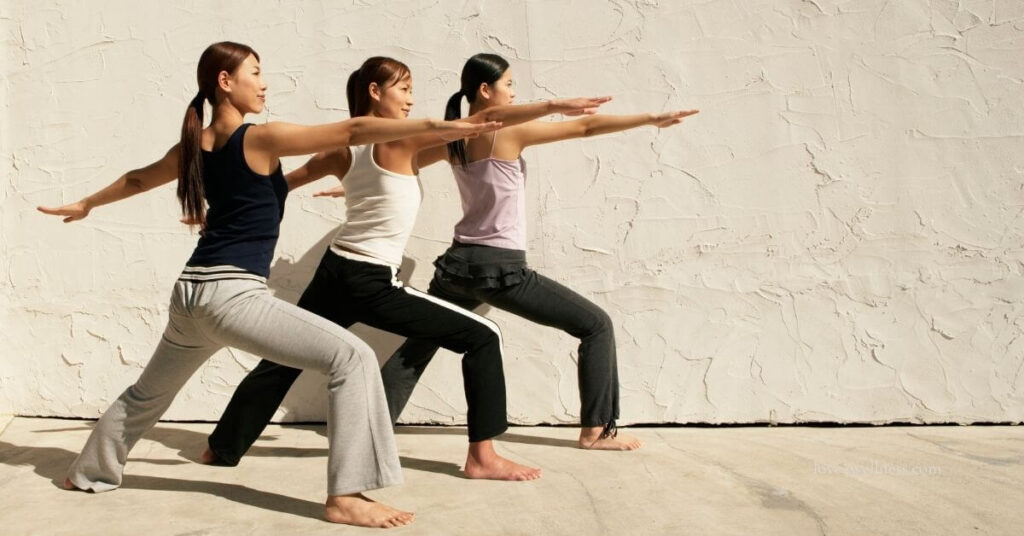
This strong standing pose builds strength and stability while opening the hips and chest, helping to release tension that accumulates in the upper back and shoulders.
How to do it:
- Start in a wide stance, with your feet about 3 to 4 feet apart.
- Turn your right foot out 90 degrees and your left foot in slightly. Align your front heel with the arch of your back foot.
- On an exhale, bend your front knee until it’s directly over your ankle. Keep your front thigh parallel to the floor.
- Extend your arms out to the sides, parallel to the floor. Keep your shoulders relaxed and your palms facing down.
- Turn your head to look over your right fingertips. Actively lengthen through your arms and feel the stretch across your chest and shoulders.
- Stay here for several breaths, then repeat on the other side.
Benefits for neck & shoulders: Warrior II strengthens the shoulders and upper back muscles, which helps to improve posture and counteract a forward-sloping chest. The extended arms and open chest work to release tightness and tension, directly benefiting those with neck and shoulder pain.
4. Triangle pose (Trikonasana)
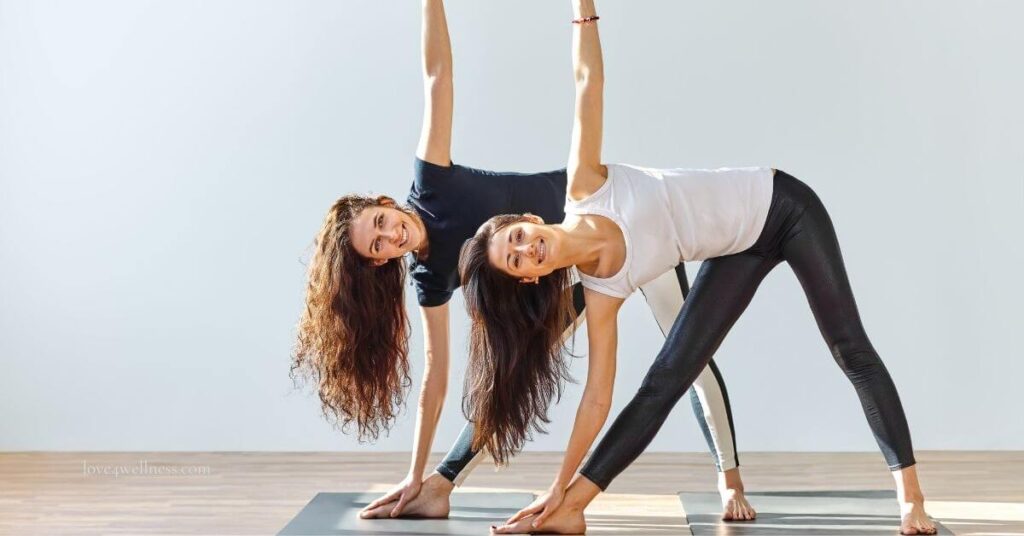
Triangle Pose is a powerful standing stretch that lengthens the side body, hamstrings, and groin while also opening the chest and shoulders, making it excellent for releasing deep-seated tension.
How to do it:
- Start in a wide stance, similar to Warrior II. Turn your right foot out 90 degrees and your left foot in slightly.
- Inhale and extend your arms out to the sides, parallel to the floor.
- On an exhale, hinge from your right hip, reaching your right hand forward. When you can no longer reach, bring your right hand to your shin, ankle, or a block.
- Extend your left arm straight up toward the ceiling, creating a straight line from your right hand to your left.
- Turn your head to look up at your top hand, keeping your neck long.
- Actively open your chest to the side, as if you’re leaning back against a wall. Hold the pose for several breaths, then repeat on the other side.
Benefits for neck & shoulders: This pose provides a deep stretch along the side of the torso, which can relieve tension in the intercostal muscles and lats, reducing strain on the shoulders. The chest-opening action helps to counteract the forward hunching that contributes to neck and shoulder pain, promoting better posture.
5. Puppy pose (Uttana Shishosana)

This gentle forward-bend is a wonderful pose for deeply stretching the spine, shoulders, and upper back, making it a powerful reliever of “tech neck.”
How to do it:
- Start on your hands and knees in a tabletop position.
- Walk your hands forward, keeping your hips stacked directly over your knees.
- Lower your forehead toward the mat, allowing your chest to sink toward the floor. You can rest your forehead on the mat, a block, or a blanket.
- Keep your arms active and your palms on the floor, or you can bring your hands into a prayer position and bend your elbows, bringing your hands to the back of your neck.
- Breathe deeply, feeling the stretch across your chest and down your upper back.
- Stay in this pose for several breaths, then slowly press back up to the tabletop.
Benefits for neck & shoulders: Puppy Pose is a fantastic opener for the shoulders and chest. It lengthens the spine and provides a deep, therapeutic stretch to the upper back and triceps. This directly helps to alleviate the tension and stiffness that builds up from hunching over a desk or phone.
6. Sphinx pose (Salamba Bhujangasana)
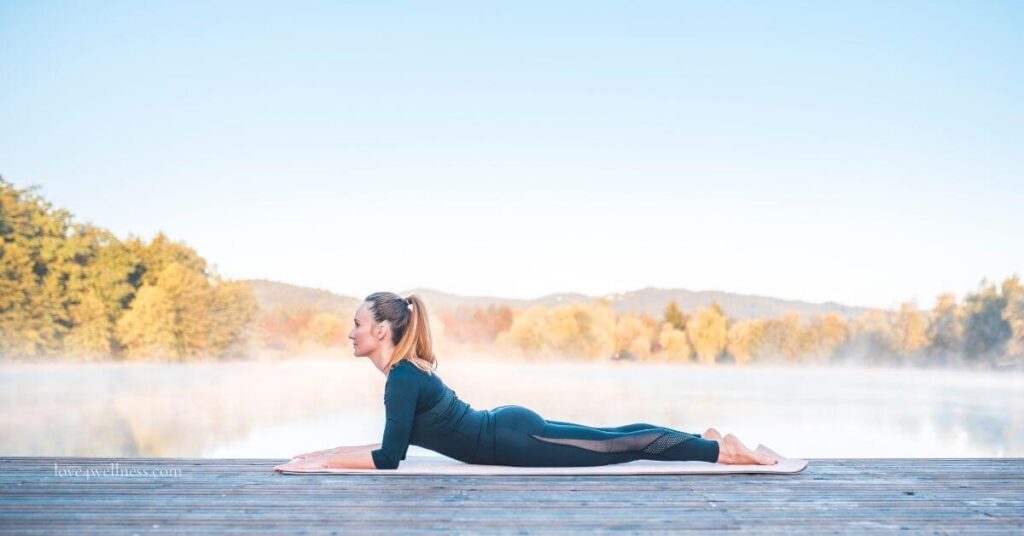
This gentle backbend is a restorative and accessible pose that helps to strengthen the back muscles and open the chest, providing relief from a hunched-over posture.
How to do it:
- Lie on your stomach with your legs extended behind you, feet hip-width apart.
- Place your elbows directly under your shoulders, with your forearms parallel to each other and your palms flat on the floor.
- Gently press your forearms and hands into the mat as you lift your head and chest. Keep your shoulders relaxed and pulled away from your ears.
- Lengthen your spine and look straight ahead, avoiding any tension in your neck.
- Breathe deeply and stay in the pose for several breaths, then gently lower your chest and head back down.
Benefits for neck & shoulders: Sphinx Pose helps to strengthen the muscles of the lower and upper back, which support the spine and prevent slouching. By gently lifting the chest and opening the heart space, it counteracts the forward-pulling action of the shoulders that is common with “tech neck,” helping to realign the spine and relieve stiffness.
7. Seated twist (Ardha Matsyendrasana)

This deeper seated twist provides a powerful stretch for the spine and shoulders, helping to increase flexibility and release deep-seated tension in the upper back.
How to do it:
- Sit on the floor with both legs extended forward.
- Bend your right knee and place your right foot on the outside of your left thigh, flat on the floor.
- Tuck your left leg under, so your left heel is near your right hip.
- Inhale and lengthen your spine, then place your right hand on the floor behind you.
- Exhale and twist your torso to the right. Bring your left elbow to the outside of your right knee, or hug your right knee with your left arm.
- Turn your head to look over your right shoulder. Keep your shoulders relaxed and your spine tall.
- Hold for several breaths, then gently release and repeat on the other side.
Benefits for neck & shoulders: This twist deeply mobilises the entire length of the spine, from the base of the tailbone to the neck. The twisting action helps to wring out tension and stiffness in the upper back muscles, improving posture and relieving the chronic tightness that often leads to neck and shoulder pain.
8. Cow face pose

This deep stretch is highly effective for improving mobility in the shoulders and hips. It specifically targets the shoulder joint, which can help to relieve chronic stiffness and tension in the upper back.
How to do it:
- Start in a seated position. Stack your right knee directly on top of your left knee, with both feet drawn back toward your hips. If this is too intense, simply sit cross-legged.
- Inhale and reach your right arm straight up toward the ceiling. On an exhale, bend your right elbow and drop your right hand down your back.
- Reach your left arm out to the side, then behind your back. Bend your left elbow and try to clasp your hands together behind you.
- If your hands don’t meet, you can use a yoga strap or a towel to bridge the gap.
- Sit up tall and breathe deeply. Relax your shoulders and avoid tensing your neck.
- Hold the pose for several breaths, then gently release and repeat on the other side.
Benefits for neck & shoulders: Cow Face Pose provides a deep, therapeutic stretch to the shoulder joints, chest, and triceps. This action helps to open tight shoulders and release the muscular tension that causes pain. It also improves range of motion, which is essential for correcting the forward-slouching posture associated with tech neck.
9. Leg up the wall pose (Viparita Karani)
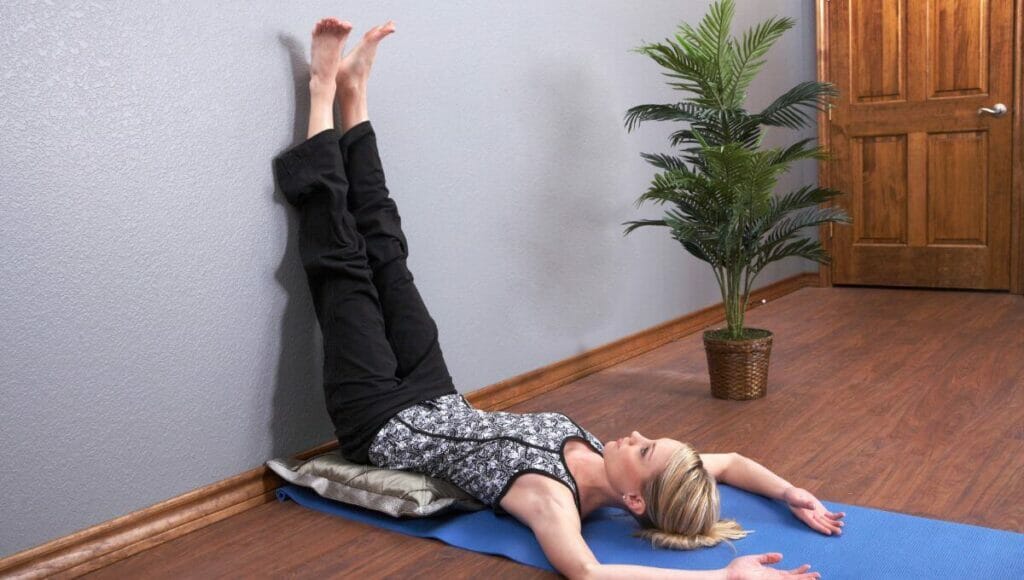
This gentle, restorative inversion is a perfect way to end your practice. It calms the nervous system, relieves tired legs, and offers a passive release of tension throughout the body.
How to do it:
- Sit with one hip touching a wall.
- Carefully swing your legs up the wall as you lower your back to the floor. Your sitting bones should be as close to the wall as is comfortable.
- Adjust your position so your body forms an ‘L’ shape, with your legs straight up the wall and your back flat on the floor. You can place a folded blanket or a cushion under your lower back for extra support.
- Rest your arms by your sides, with your palms facing up, or place one hand on your heart and the other on your belly.
- Allow your neck and head to rest comfortably on the mat. Close your eyes and breathe deeply.
- Stay in this pose for 5-15 minutes. To come out, gently bend your knees and roll to one side before slowly pushing yourself up to a seated position.
Benefits for neck & shoulders: While this pose doesn’t directly stretch the neck and shoulders, its profound relaxation benefits are key. Calming the nervous system helps to release the mental and physical stress that causes muscles to tense up. The gentle reversal of blood flow can also help reduce inflammation and stiffness, providing passive relief for chronic neck and shoulder pain.
10. Corpse pose (Savasana)
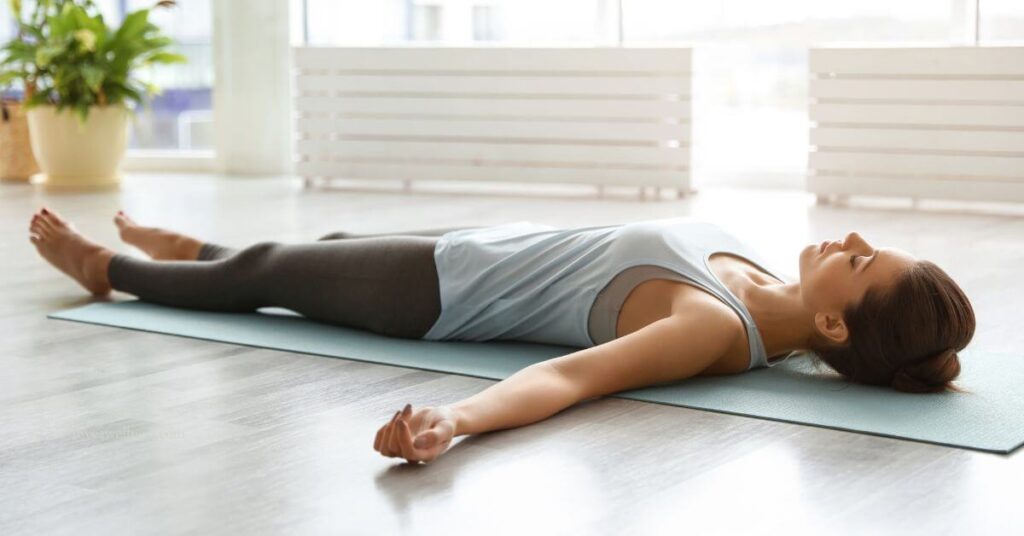
Savasana is the final and most important pose in any yoga practice. It allows your body to absorb all the benefits of the poses you’ve done, promoting complete physical and mental relaxation.
How to do it:
- Lie flat on your back with your legs extended, feet about hip-width apart and toes naturally falling out to the sides.
- Rest your arms by your sides, about 6-12 inches away from your body, with your palms facing up.
- Close your eyes and allow your entire body to become heavy, releasing all muscle tension.
- Begin to notice your breath without trying to control it. Let go of any lingering thoughts or sensations.
- Remain in this state of conscious rest for at least 5-10 minutes.
Benefits for neck & shoulders: Savasana is the ultimate pose for releasing tension. By lying flat and still, you allow the muscles of your neck and shoulders to completely relax and let go of any tightness they were holding on to. It calms the nervous system, which in turn reduces physical stress and muscular stiffness, providing profound relief from pain and discomfort.
Beginners can also do
Some do’s to remember
- Remember to gently get in and out of the poses, avoiding any jerky movements.
- When staying in a pose, breathe deeply and enjoy the stretch.
- In case of any pain, slowly come out of the pose.
- Be mindful of how your body responds to each of these poses.
DID YOU KNOW? Tension and tightness in your neck and shoulder are symptoms of stress and anxiety.
Tweet
Start with 2-3 of these poses daily for a week and notice how your neck feels. If a friend also suffers from tech neck, send them this article.

